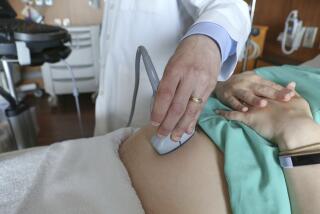Short or Heavy Women Most Likely to Have Difficult Labors
- Share via
Women who are tall or not overweight tend to have easier labors than women who are short or heavy, according to a Canadian study in the American Journal of Obstetrics and Gynecology.
Women who report they are highly anxious about childbirth are not likely to have difficult labors, the researchers also found, perhaps because they express rather than repress their fears.
“Women 5-feet-2 and under were more than twice as likely to have difficult labors than those 5-feet-5 and taller,” said Molly Thomson, an epidemiologist with the Ministry of Health in British Columbia who with James Hanley, assistant professor of epidemiology at McGill University in Montreal, studied 781 women who gave birth at two Canadian hospitals.
About 10% of the tall women in the study and 27% of the short women had difficult labors, Thomson said, adding, “the heaviest 25% of women had more difficult labors than the lightest 25%.”
“Difficult labor was more consistently predicted by heaviness of the woman rather than by heaviness of the infant,” wrote the researchers.
Thomson and Hanley studied only the first stage of labor, defining it from “the time of hospital admission to full cervical dilation,” and termed it difficult if it exceeded 15 hours or if a Caesarean section was necessary.
Short stature may correlate with a small pelvic opening, the researchers speculate, thus making childbirth more difficult. Why extra weight is related to difficult labor isn’t known, Thomson said.
The research is preliminary and is not meant to frighten women who are short, said Thomson, who pointed out that many short women (73%) in the study did not have difficult labors. Nor does the tendency always hold up, said Thomson, who is 5-feet-11 and had a “moderately long” labor with one of her three children.
Based on the study results, Thomson advises women not to gain too much weight before pregnancy. And, emphasizing that the advice is based on preliminary findings, she said: “Instead of expressing their fears through their bodies when giving birth, women should work through their worries about childbirth during pregnancy.”
Children and Caffeine
Adults may not be the only ones experiencing “caffeine nerves.” A new study suggests it may be a problem among children as well.
In a survey of more than 1,200 children (with the help of some of their parents), about 33% of 6-month-olds and 77% of children ages 1 to 17 consumed caffeine in a 24-hour period, according to Louisiana State University Medical Center researchers in New Orleans.
The number consuming foods with caffeine doubled between ages 6 months and 1 year, wrote the researchers in a recent issue of the Journal of the American Dietetic Assn. The highest caffeine consumption was found among 2- and 3-year-olds.
The most commonly eaten caffeine-containing foods? Items with chocolate, carbonated beverages and tea. Chocolate-milk beverages, puddings and ice creams were especially popular among 10-year-olds. More than half of the 6-month-olds who consumed caffeine drank carbonated beverages, the researchers found.
To minimize caffeine intake, Jo Ann Hattner, a registered dietitian at Children’s Hospital at Stanford and a spokeswoman for the American Dietetic Assn., offered these suggestions:
--Buy the caffeine-free varieties of soft drinks.
--Be aware that chocolate is a source of caffeine.
--Take into account body weight of children and allow only moderate amounts of caffeine-containing foods and drinks. “A 3-year-old, for example, should probably not have more than one serving of a caffeine-containing food or drink a day,” she said.
TMJ Syndrome Surgery
Treating temporomandibular joint syndrome with minimal incision surgery through an arthroscope, a special viewing instrument, has about the same success rate as traditional surgical methods that require larger incisions, a Bellflower oral surgeon told colleagues attending a recent dental seminar in Coronado.
Treating TMJ with arthroscopic surgery results in an 85% overall success rate, said Dr. Ronald Kaminishi, an oral and maxillofacial surgeon and assistant clinical professor at the USC School of Dentistry.
In the unpublished study comparing the two surgical techniques for treating the painful jaw disorder, Kaminishi and his partner, Dr. Chris Davis, an assistant clinical professor at the USC School of Dentistry, surveyed 1,400 TMJ patients at 13 centers in the United States, Australia and Japan.
Treating TMJ patients with arthroscopic surgery usually makes hospitalization unnecessary and reduces disability time, Kaminishi said, in much the same way that arthroscopic surgery has helped simplify knee surgery. The arthroscopic incision for TMJ treatment is about 1/16 of an inch; the traditional surgery requires an incision of about 2 inches, he said. About 15% of oral surgeons are now using the arthroscope to some degree, Davis said.
Not all of the estimated 30% of patients who need surgery for TMJ are good candidates for arthroscopic surgery, Kaminishi said. Those who need extensive reconstruction of the joint, for example, are better off undergoing traditional surgery, he said.





